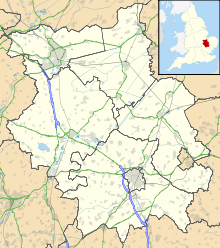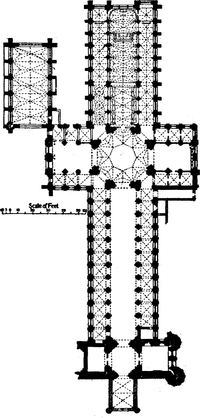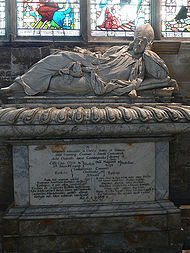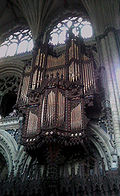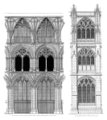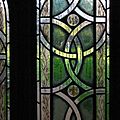- Ely Cathedral
-
Ely Cathedral Cathedral Church of the Holy and Undivided Trinity 
The West Tower (1174-97)Shown within Cambridgeshire 52°23′55″N 0°15′51″E / 52.398611°N 0.264167°ECoordinates: 52°23′55″N 0°15′51″E / 52.398611°N 0.264167°E Location Ely, Cambridgeshire Country England Denomination Church of England Tradition Broad church Website www.elycathedral.org Architecture Style Romanesque, Gothic Years built 1083-1375 Specifications Length 163.7m Height 66m Nave height 21.9m Number of towers 2 Tower height 66m (west tower), 52m (lantern) Administration Diocese Ely (since 1109) Province Canterbury Clergy Dean Very Revd Dr Michael Chandler
(Vice Dean) Revd Canon David PritchardCanon(s) (Canon Missioner) Revd Canon Dr Alan Hargrave, (Chapter Canon) Revd Canon Hugh Shilson-Thomas Precentor Revd Canon Dr. James Garrard (effective 29 November 2008)[1] Laity Director of music Paul Trepte Organist(s) Jonathan Lilley Ely Cathedral (in full, The Cathedral Church of the Holy and Undivided Trinity of Ely) is the principal church of the Diocese of Ely, in Cambridgeshire, England, and is the seat of the Bishop of Ely and a suffragan bishop, the Bishop of Huntingdon. It is known locally as "the ship of the Fens", because of its prominent shape that towers above the surrounding flat and watery landscape.
Contents
History
Most of what is known about the early history of Ely comes from Bede's Historia ecclesiastica gentis Anglorum and above all from the Liber Eliensis, an anonymous chronicle written at Ely some time in the 12th century and covering the history of the Abbey and Cathedral from 673 until the mid-12th century.
Previous buildings
See also: List of abbots and abbesses of ElyThe first Christian building on the site was founded by St. Æthelthryth (romanised as "Etheldreda"), daughter of the Anglo-Saxon King Anna of East Anglia, who was born in 630 at Exning near Newmarket.[2] She may have acquired land at Ely from her first husband Tondberht, described by Bede as a "prince" of the South Gyrwas.[3] After the end of her second marriage to Ecgfrith, a prince of Northumbria, she set up and ruled a monastery at Ely in 673, and, when she died, a shrine was built there to her memory. The monastery is traditionally believed to have been destroyed in the Danish invasions of the late 9th century, together with what is now the city. However, while the lay settlement of the time would have been a minor one, it is likely that a church survived there until its refoundation in the 10th century.[4]
A new Benedictine monastery was built and endowed on the site by Athelwold, Bishop of Winchester, in 970, in a wave of monastic refoundations which locally included Peterborough and Ramsey.[5] This became a cathedral in 1109, after a new Diocese of Ely was created out of land taken from the Diocese of Lincoln.
The present building
Overview and dimensions
The cathedral is built from stone quarried from Barnack in Northamptonshire (bought from Peterborough Abbey, whose lands included the quarries, for 8000 eels a year), with decorative elements carved from Purbeck Marble and local clunch. The plan of the building is cruciform (cross-shaped), with an additional transept at the western end. The total length is 537 feet (163.7 m),[6] and the nave at over 75 m long (250 ft) remains one of the longest in Britain. The west tower is 66m high (215 ft). The unique Octagon 'Lantern Tower' is 23 m (74 ft) wide and is 52 m (170 ft) high. Internally, from the floor to the central roof boss the lantern is 43 m (142 ft) high.
Abbot Simeon's Cathedral
The present cathedral was started by Abbot Simeon (1082–1094, brother of Walkelin, the then bishop of Winchester) under William I in 1083. Building continued under Simeon's successor, Abbot Richard (1100–1107). The Anglo-Saxon church was demolished, but some of its relics, such as the remains of its benefactors, were moved to the cathedral. The main transepts were built early on, crossing the nave below a central tower, and are the oldest surviving part of the cathedral. Construction work continued throughout the 12th century. The Western transepts and tower were completed under Bishop Ridel (1174–89) in an exuberant Romanesque style with a rich decoration of intersecting arches and complex mouldings.
Early Gothic elements
A Galilee porch was added under Bishop Eustace (1198–1215) in the Early English Gothic style. It was originally a two-storey structure (it was opened up into a single vaulted space in the 18th century) where liturgical processions could gather before entering the nave. Several details of its decoration, particularly the 'syncopated arches' and the use of Purbeck marble shafts, reflect the influence of St Hugh's Choir at Lincoln Cathedral, built a few years earlier.
Under Bishop Northwold, work began on a new eastern end in 1234, replacing the short Norman chancel with a much grander 10-bay structure. Northwold's chancel, completed by around 1252, adopted several of the stylistic elements already used in the Galilee porch.
Later Gothic elements
In 1321, under the sacrist Alan of Walsingham work began on a massive (100' long by 46' wide) free-standing Lady Chapel, linked to the north transept and the north aisle of the chancel by covered walkways. This new structure was built in an exuberant 'Decorated' Gothic style. Around most of the wall surface are sedilia-like niches, flanked by pilasters of Purbeck marble and covered by sinuous ogee arches which project forward away from the wall (sometimes known as 'knodding ogees'). Most wall surfaces are covered with richly carved vegetal and diaper patterns which were originally brightly polychromed. An extensive sculpted Life of the Virgin cycle originally filled the spandrels between the niches but this was severely damaged by iconoclasts (either following the Dissolution of the Monasteries or by Puritans during the English Civil War - historians still disagree over which).
In February 1322, possibly as a result of instabilities caused by the digging of the foundations for the Lady Chapel, the great Norman crossing tower collapsed, injuring nobody but damaging the first four bays of Bishop Northwold's Early Gothic choir. These western bays of the liturgical choir were rebuilt in a more modern style. More noticeably, the old crossing tower was replaced by an innovative octagonal lantern. Although it is supported on eight massive masonry piers, the lantern itself is constructed from oak timbers and was designed by William Hurley, who later became Master Carpenter to the King at Westminster. Because the crossing was a key part of the liturgical choir, this rebuilding work took priority over other activities and the lantern was largely complete by 1340. The windows on the sides of the upper octagon are a particularly successful way of lighting the centre of the cathedral. The angels painted below the windows are however purely Victorian inventions, a product of the restoration under Thomas Gambier Parry in 1874. When built, the Octagon was the largest crossing span in northern Europe and remains Ely Cathedral's most distinctive feature, visible from miles around across the Fens.
Dating from the early 16th century is a set of 44 misericords.
Later history
In 1539, during Henry VIII's Dissolution of the Monasteries, the cathedral suffered only minor damage, but St Etheldreda's shrine was destroyed. The cathedral was soon refounded in 1541, although many of the statues in the lady chapel were severely damaged.
The Bishop of Ely in the mid 17th century was Matthew Wren and in connection with this, his nephew Christopher Wren was responsible for a rather splendid Gothic door, dating from the 1650s, on the north face of the cathedral.
The building has been the subject of several major restoration projects:
- in the 18th century, under James Essex;
- in 1839, under George Peacock, with the architect George Gilbert Scott (the architect Basevi died in a fall from the west tower). A painted wooden ceiling was added to the nave in this restoration.
- from 1986 to 2000
Burials
- Saint Eadnoth the Younger
- Wulfstan II - buried in the monastery
- Byrhtnoth - leader of Anglo-Saxon forces at the Battle of Maldon, 991.
- Hervey le Breton, Bishop of Ely (1109–1131)
- Nigel - may have been buried here
- Geoffrey Ridel, the nineteenth Lord Chancellor of England and Bishop of Ely (1173–1189)
- Eustace, also the twenty-third Lord Chancellor of England and Lord Keeper of the Great Seal
- Geoffrey de Burgo, Bishop of Ely (1225–1228)
- Hugh of Northwold, Bishop of Ely (1229–1254)
- William of Kilkenny, Lord Chancellor of England and Bishop of Ely (1254–1256) - his heart was buried here, having died in Spain on a diplomatic mission for the king
- Hugh de Balsham, Bishop of Ely (1256–1286)
- John Kirkby, Lord High Treasurer of England and Bishop of Ely (1286–1290)
- William of Louth, Bishop of Ely (1290–1298)
- William Grey, Lord High Treasurer of England and Bishop of Ely (1454–1478)
- John Alcock, Lord Chancellor of England and Bishop of Ely (1486–1500) - in the Alcock Chantry
- Nicholas West, Bishop of Ely (1515–1534) - in a chapel he built
- Richard Cox, Bishop of Ely (1550–1581) - is buried under choir box. (tomb was covered when they built choir box)
- Peter Gunning, Bishop of Ely (1675–1684)
- John Moore (bishop of Ely)
- William Fleetwood, Bishop of Ely (1714–1723)
- Robert Butts, Bishop of Ely (1738–1748)
- Matthias Mawson, Bishop of Ely (1754–1771)
- Edmund Keene, Bishop of Ely (1771–1781) - in West's Chapel (his wife, Mary, was buried in the south side of the choir)
- James Woodford, Bishop of Ely (1873–1885) - in Bishop Wren's chapel on the south side of the cathedral choir
Stained Glass Museum
The south gallery of the nave is home to The Stained Glass Museum, a collection of stained glass from the 13th century to the present that is of national importance and includes works from notable contemporary artists including Ervin Bossanyi.
Music
Ely has a cathedral choir of boys and men, which has recently attracted international attention because of its association with The Choirboys: two of its members, Patrick Aspbury and CJ Porter-Thaw, are choristers at the cathedral. Boys are educated in the junior department of The King's School, Ely.
The Ely Cathedral Girls' Choir was also launched in 2006, comprising 18 girl choristers. The choir's debut CD, Sing reign of fair maid: Music for Christmas and the New Year, directed by Sarah MacDonald, is available from Regent Records.
The cathedral community also has an adult voluntary choir, The Ely Cathedral Octagon Singers and a children's choir The Ely Imps.
Organ
Details of the organ from the National Pipe Organ Register
Organists
- 1453 William Kyng
- 1535 Thomas Barcroft
- 1541 Christopher Tye
- 1562 Robert White
- 1567 John Farrant
- 1572 William Fox
- 1579 George Barcroft
- 1610 John Amner
- 1641 Robert Claxton
- 1662 John Ferrabosco
- 1681 James Hawkins
- 1729 Thomas Kempton
- 1762 John Elbonn
- 1768 David Wood
- 1774 James Rogers
- 1777 Richard Langdon
- 1778 Highmore Skeats (sen.)
- 1804 Highmore Skeats (jun.)
- 1830 Robert Janes
- 1867 Edmund Thomas Chipp
- 1887 Basil Harwood
- 1892 Thomas Tertius Noble
- 1898 Hugh Allen
- 1901 Archibald Wilson
- 1919 Noel Ponsonby
- 1926 Hubert Stanley Middleton
- 1931 Marmaduke Conway
- 1949 Sidney Campbell
- 1953 Michael Howard
- 1958 Arthur Wills
- 1990 Paul Trepte
Assistant organists
- Mr. Bailey ???? - 1857
- William J. Kempton ???? - 1865
- George Legge
- William George Price (later organist to the City of Melbourne)
- Frederick Chubb 1903 - 1906
- Harold Carpenter Lumb Stocks 1906 - 1909
- Edwin Alec Collins 1911 - 1915[7]
- Guillaume Ormond 1927 - 1929 (afterwards organist of Truro Cathedral)
- William Bean
- C.P.R. Wilson 1939
- Russell Missin 1945 - 1949
- Arthur Wills 1949 - 1958
- Michael Dudman 1961 - 1964
- Anthony Greening 1964 - 1966
- Roger Judd
- Gerald Gifford 1973 - 1976
- Stephen Le Prevost 1977 - 1989
- Jeremy Filsell 1989 - 1991
- David Price 1991 - 1996 (Now organist of Portsmouth Cathedral)
- Sean Farrell 1996 - 1998
- Scott Farrell 1999 - 2002
- Jonathan Lilley 2002 -
- Edward Taylor (assistant for the Girls' Choir now Assistant Organist at Carlisle Cathedral)
- Oliver Hancock (current assistant for the Girls' Choir)
Directors of Ely Cathedral Girls' Choir
- Louise Reid 2006 - 2007
- Sarah MacDonald 2008
- Louise Reid 2009 - 2010
- Sarah MacDonald 2010 -
The Chapter
As of November 2011[update], the Chapter consists of:[8]
Residentiary Chapter
- The Dean - vacant
- The Acting Dean and Canon Pastor, The Revd Canon David Pritchard
- The Canon Precentor, The Revd Canon Dr James Garrard
- The Canon Missioner, The Revd Canon Dr Alan Hargrave
Non-residentiary Chapter
- Canon Susan Pope
- Canon Tom Green
- Canon Rosemary, Lady Hughes
- The Revd Canon Hugh Shilson-Thomas
The Chapter is assisted by the Minor Canons and Priest Vicars:
Minor Canons
- The Revd Toby Humphry (Chaplain of the King's School, Ely)
- The Revd Professor Sarah Coakley
- The Revd David Herrick
Priest Vicars
- The Revd Canon Chris Barber
- The Revd Canon Michael Law
- The Revd Canon Bruce Curry
- The Revd Eric Rowland
- The Revd John Sansom
- The Revd Peter Beech
- The Revd Canon Colin Travers
Honorary Canons
- 1989 John Beer
- 1999 Timothy Elbourne
- 2001 Jonathan Young
- 2003 Vanessa Herrick
- 2004 Margaret Guite
- 2004 Richard Longfoot
- 2004 Hugh McCurdy
- 2004 Les Oglesby
- 2004 Owen Spencer-Thomas
- 2005 Fiona Brampton
- 2005 Andrew Greany
- 2005 Jane Keiller
- 2005 Stephen Leeke
- 2005 Shamus Williams
- 2007 Peter Baxendall
- 2007 John Binns
- 2007 Stephen Earl
- 2008 Richard Darmody
- 2008 Malcolm Griffith
- 2008 Martin Seeley
- 2008 Fraser Watts
- 2008 David Thomson[9]
- 2010 Sue Wyatt
- 2010 Brian Atling
- 2010 Michael Goater
In popular culture
- The cathedral appears on the cover of Pink Floyd's 1994 album The Division Bell.
- A number of John Rutter's choral albums feature the cathedral, a reference to early recordings of his music being performed and recorded in the Lady chapel.
- Direct references to the cathedral appear in the children's book Tom's Midnight Garden by Philippa Pearce. A full-length movie with the same title was released in 1999.
- A section of the film Elizabeth: The Golden Age was filmed at the cathedral.
- Filming for The Other Boleyn Girl took place at the cathedral in August 2007.
- Parts of Marcus Sedgwick's 2000 novel Floodland take place at the cathedral after the sea has consumed the land around it turning Ely into an island.
- Direct references to Ely Cathedral are made in Jill Dawson's novel Watch Me Disappear.
- A week's filming took place in November 2009 at the cathedral, when it substituted for Westminster Abbey in The King's Speech.
See also
- List of cathedrals in the United Kingdom
- Architecture of the medieval cathedrals of England
- St Etheldreda's Church
- English Gothic architecture
- Romanesque architecture
- Church of England
References
- ^ News of appointment of Dr James Garrard as Precentor to the Cathedral
- ^ For the origin of the word "tawdry", see Æthelthryth.
- ^ Bede, Ecclesiastical History, iv, 19.
- ^ Whitelock, D., 'The Conversion of the Eastern Danelaw', in Saga-Book of the Viking Society 12, London 1941.
- ^ [1] Consumption and Pastoral Resources on the Early Medieval Estate, accessed July 12, 2007
- ^ The English Cathedral. Tatton-Brown, T. and Crook, J. ISBN 1-84330-120-2
- ^ Who's who in Music. Fourth Edition. 1962. p.44
- ^ Ely Cathedral website
- ^ Diocese of Ely Directory 2008
Further reading
- W. E. Dickson. Ely Cathedral (Isbister & Co., 1897).
- Richard John King. Handbook to the Cathedrals of England - Vol. 3, (John Murray, 1862).
- D. J. Stewart. On the architectural history of Ely cathedral (J. Van Voorst, 1868).
- Peter Meadows and Nigel Ramsay, eds., A History of Ely Cathedral (The Boydell Press, 2003).
- Lynne Broughton, Interpreting Ely Cathedral (Ely Cathedral Publications, 2008).
- John Maddison, Ely Cathedral: Design and Meaning (Ely Cathedral Publications, 2000).
- Janet Fairweather, trans., Liber Eliensis: A History of the Isle of Ely from the Seventh Century to the Twelfth Compiled by a Monk of Ely in the Twelfth Century (The Boydell Press, 2005).
- Peter Meadows, ed., Ely: Bishops and Diocese, 1109-2009 (The Boydell Press, 2010).
Gallery
-
Engraving of Ely Cathedral, ca. 1830.
-
Beautifully detailed stained glass window in the nave
External links
- Ely Cathedral
- 360° interior panorama at BBC Cambridgeshire
- The Stained Glass Museum at Ely Cathedral.
- A history of the choristers of Ely Cathedral
- Flickr images tagged Ely Cathedral
- Article about the medieval stained glass in the Lady chapel http://www.vidimus.org/archive/issue_22_2008/issue_22_2008-03.html
Cathedrals of the Church of England Province of
CanterburyBirmingham • Bristol • Bury St Edmunds • Canterbury • Chelmsford • Chichester • Coventry • Derby • Ely • Exeter • Gibraltar • Gloucester • Guildford • Hereford • Leicester • Lichfield • Lincoln • Norwich • Oxford (Christ Church) • Peterborough • Portsmouth • Rochester • St Albans • St Paul's (London) • Salisbury • Southwark • Truro • Wells • Winchester • WorcesterProvince of
YorkBenedictine abbeys and priories in medieval England and Wales Independent houses Abergavenny · Abbotsbury · Abingdon · Alcester · Athelney · Bardney · Bath · Battle · Bedford · Birkenhead · Bradwell · Buckfast · Burton · Bury St Edmunds · Canterbury (Christ Church) · Canterbury (St Augustine's) · Canwell · Cerne · Chertsey · Chester · Cholsey · Colchester · Coventry · Crowland · Durham · Ely · Evesham · Eynsham · Faversham · Glastonbury · Gloucester · Humberston · Luffield · Malmesbury · Milton · Monk Bretton · Muchelney · Mullicourt · Norwich (Holy Trinity) · Pershore · Peterborough · Ramsey · Reading · Rochester · St Albans · St Benet of Hulme · Sandwell · Selby · Sherborne · Shrewsbury · Snelshall · Tavistock · Tewkesbury · Thorney · Upholland · Walden · Westminster · Whitby · Winchcombe · Winchester (New Minister) · Winchester (St Swithun) · Worcester · York (St Mary's)

Dependent houses Aldeby · Alkborough · Alcester · Alvecote · Beadlow · Bedemans Berg · Belvoir · Binham · Brecon · Bristol · Bromfield · Cardiff · Cardigan · Cranborne · Darenth · Deeping · Dover · Dunster · Earls Colne · Ewenny · Ewyas Harold · Exeter · Farne · Felixstowe · Finchale · Freiston · Great Malvern · Hatfield Peverel · Henes (Sandtoft) · Hereford · Hertford · Holy Island · Horton · Hoxne · Hurley · Jarrow · Kidwelly · Kilpeck · Kings Lynn · Lamanna · Leominster · Leonard Stanley · Lincoln · Little Malvern · Littlemore · Lytham · Middlesbrough · Monkwearmouth · Morville · Norwich (St Leonard) · Oxford (of Canterbury) · Oxford (of Durham) · Oxford (of Gloucester) · Penwortham · Pilton · Redbourn · Richmond · Rumsburgh · St Bees · St Ives · Scilly · Snaith · Snape · Stamford · Studley · Sudbury · Tickhill · Tynemouth · Wallingford · Westbury-on-Trym · Wetheral · Wymondham · Yarmouth
Alien priories Allerton Mauleverer · Andover · Andwell · Appuldurcombe · Arundel · Astley · Aston Priors · Atherington · Avebury · Axmouth · Blyth · Boxgrove · Brimpsfield · Burstall · Burwell · Caldy · Carisbrooke · Chepstow · Clatford · Cogges · Corsham · Covenham · Cowick · Creeting · Debden · Deerhurst · Dunwich · Ecclesfield · Edith Weston · Ellingham · Everdon · Eye · Folkestone · Frampton · Goldcliff · Grovebury · Hamble · Harmondsworth · Hatfield Regis · Haugham · Hayling · Headley · Hinckley · Holbeck · Horsham St Faith · Horsley · Lancaster · Lapley · Lewisham · Linton (or Isleham) · Livers Ocle · Llangennith · Llangua · Loders · Minster · Minster Lovell · Minting · Modbury · Monks Kirkby · Monk Sherbourne · Monmouth · Newent · Ogbourne St George · Otterton · Panfield · Pembroke · Pill · Ruislip · Runcton · St Cross · St Dogmells · St Michael's Mount · St Neots · Sele · Spalding · Sporle · Standon · Steventon · Stogursey · Stoke-by-Clare · Stratfied Saye · Swavesey · Takeley · Throwley · Tickford · Titley · Toft Monks · Totnes · Tutbury · Tywardreath · Upavon · Ware · Wareham · Warminghurst · Warmington · Wath · Weedon Beck · Weedon Lois · West Mersea · Wilsford · Wing · Winghale · Wolston · Wootton Wawen · York (Holy Trinity)
Categories:- Anglican cathedrals in England
- Buildings and structures in Cambridgeshire
- Ely, Cambridgeshire
- Monasteries in Cambridgeshire
- Norman architecture
- English Gothic architecture
- Visitor attractions in Cambridgeshire
- Benedictine monasteries in England
- Grade I listed cathedrals
- Grade I listed buildings in Cambridgeshire
- Museums in Cambridgeshire
- Art museums and galleries in Cambridgeshire
- Glass museums and galleries
- 12th-century church buildings
Wikimedia Foundation. 2010.

